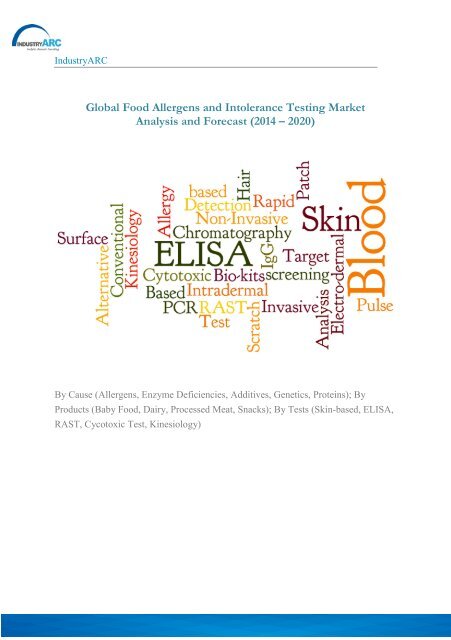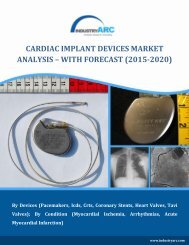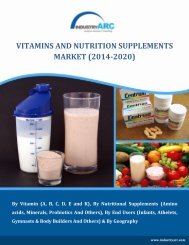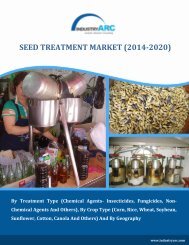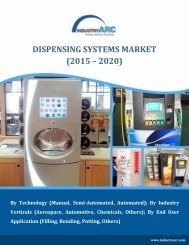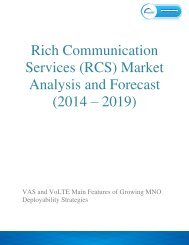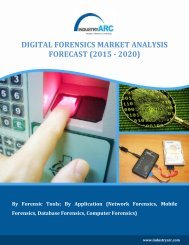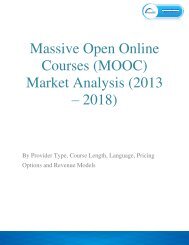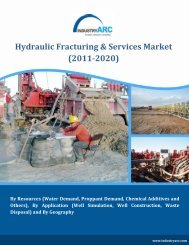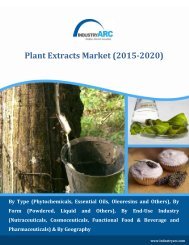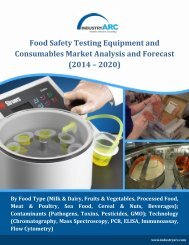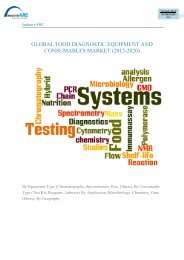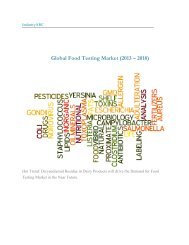Food allergens and intolerance market
An Allergen is any substance, often a protein which induces an allergy. Thus, a food allergy is the allergy caused due to the consumption of a food allergen.
An Allergen is any substance, often a protein which induces an allergy. Thus, a food allergy is the allergy caused due to the consumption of a food allergen.
You also want an ePaper? Increase the reach of your titles
YUMPU automatically turns print PDFs into web optimized ePapers that Google loves.
IndustryARC<br />
Global <strong>Food</strong> Allergens <strong>and</strong> Intolerance Testing Market<br />
Analysis <strong>and</strong> Forecast (2014 – 2020)<br />
By Cause (Allergens, Enzyme Deficiencies, Additives, Genetics, Proteins); By<br />
Products (Baby <strong>Food</strong>, Dairy, Processed Meat, Snacks); By Tests (Skin-based, ELISA,<br />
RAST, Cycotoxic Test, Kinesiology)
TABLE OF CONTENTS<br />
1. Executive Summary<br />
2. Global <strong>Food</strong> Allergens <strong>and</strong> Intolerance Testing- Market Overview<br />
3. Global <strong>Food</strong> Allergens <strong>and</strong> Intolerance Testing- Market L<strong>and</strong>scape<br />
3.1. Market Share Analysis<br />
3.2. Comparative Analysis<br />
3.2.1. Product Benchmarking<br />
3.2.2. End user profiling<br />
3.2.3. Patent Analysis<br />
3.2.4. Top 5 Financials Analysis<br />
4. Global <strong>Food</strong> Allergens <strong>and</strong> Intolerance Testing- Market Forces<br />
4.1. Market Drivers<br />
4.1.1. Increasing number of food-borne illnesses <strong>and</strong> related deaths<br />
4.1.2. Rising awareness among consumers regarding <strong>Food</strong> <strong>allergens</strong> <strong>and</strong><br />
<strong>intolerance</strong><br />
4.1.3. Evolving regulatory environment increasing consumer awareness<br />
4.1.4. Thriving food processing industry propelling packaged foods<br />
consumption<br />
4.2. Market Constraints<br />
4.2.1. Technological Constraints<br />
4.2.2. Lack of awareness of symptoms <strong>and</strong> associated diseases among<br />
consumers<br />
4.3. Market Challenges<br />
4.3.1. Enforcing regulatory compliance: huge challenge
4.4. Attractiveness of the <strong>Food</strong> Allergens <strong>and</strong> Intolerance Testing Industry<br />
4.4.1. Power of Suppliers<br />
4.4.2. Power of Customers<br />
4.4.3. Threat of New entrants<br />
4.4.4. Threat of Substitution<br />
4.4.5. Degree of Competition<br />
5. Global <strong>Food</strong> Allergens <strong>and</strong> Intolerance Testing Market – Strategic Analysis<br />
5.1. <strong>Food</strong> Intolerance analysis of consumers by regions<br />
5.2. Value Chain Analysis<br />
5.3. Pricing Analysis<br />
5.4. Opportunities Analysis<br />
5.5. Product/Market Life Cycle Analysis<br />
5.6. Suppliers <strong>and</strong> Distributors<br />
6. Regulatory authorities <strong>and</strong> Regulations in key countries<br />
6.1. U.S.<br />
6.2. U.K.<br />
6.3. Germany<br />
6.4. Canada<br />
6.5. Australia<br />
6.6. Others<br />
7. <strong>Food</strong> Allergens <strong>and</strong> Intolerance Testing – Analysis by Causes<br />
7.1. Allergens<br />
7.2. Enzyme Deficiencies<br />
7.2.1. Lactose Intolerance<br />
7.2.2. Gluten Intolerance
7.2.3. Others<br />
7.3. Additives<br />
7.3.1. Antioxidants<br />
7.3.2. Flavorings<br />
7.3.3. Colorings<br />
7.3.4. Preservatives<br />
7.3.5. Sweeteners<br />
7.3.6. Thickeners<br />
7.3.7. Others<br />
7.4. Others<br />
8. <strong>Food</strong> Allergen Testing Market – By allergen/contaminant<br />
8.1. Wheat<br />
8.2. Fish<br />
8.3. Nuts<br />
8.4. Milk<br />
8.5. Egg<br />
8.6. Soy<br />
8.7. Shell fish<br />
8.8. Others<br />
9. <strong>Food</strong> Allergens Testing – By <strong>Food</strong> Type<br />
9.1. Baby food<br />
9.2. Bakery Products<br />
9.3. Dairy Products<br />
9.4. Grains & Nuts<br />
9.5. Meat & poultry
9.6. Sauces <strong>and</strong> Seasonings<br />
9.7. Others<br />
10. <strong>Food</strong> Allergen Testing- By Test Type<br />
10.1. Rapid screening tests<br />
10.1.1. Chromatography<br />
10.1.2. Others<br />
10.2. Target Detection Tests<br />
10.2.1. ELISA<br />
10.2.2. PCR<br />
10.2.3. Bio-kits<br />
10.3. Others<br />
11. <strong>Food</strong> Intolerance Testing- By Test Type<br />
11.1. Conventional Tests<br />
11.1.1. Skin based Tests<br />
11.1.1.1. Scratch Test<br />
11.1.1.2. Intradermal Test<br />
11.1.1.3. Patch Test<br />
11.1.2. Blood Tests<br />
11.1.2.1. ELISA<br />
11.1.2.2. RAST<br />
11.2. Alternative Allergy Tests<br />
11.2.1. Surface/Skin/Non-Invasive Tests<br />
11.2.1.1. Kinesiology Test<br />
11.2.1.2. Hair Analysis<br />
11.2.1.3. Pulse Test
11.2.2. Blood Based Tests/Invasive Tests<br />
11.2.2.1. IgG Blood Test<br />
11.2.2.2. Cytotoxic Test<br />
11.2.2.3. Electro-dermal Test<br />
11.2.2.4. Others<br />
12. <strong>Food</strong> Allergens <strong>and</strong> Intolerance Testing- By Geography<br />
12.1. North America<br />
12.1.1. U.S<br />
12.1.2. Canada<br />
12.1.3. Mexico<br />
12.2. Europe<br />
12.2.1. U.K.<br />
12.2.2. Germany<br />
12.2.3. France<br />
12.2.4. Spain<br />
12.2.5. Others<br />
12.3. Asia-Pacific<br />
12.3.1. India<br />
12.3.2. China<br />
12.3.3. Japan<br />
12.3.4. Australia & New Zeal<strong>and</strong><br />
12.3.5. Others<br />
12.4. ROW<br />
12.4.1. Brazil<br />
12.4.2. Middle East
12.4.3. Africa<br />
12.4.4. Others<br />
13. Market Entropy<br />
13.1. Dominant strategy : 2011-2014<br />
13.2. Market developments by key players<br />
13.3. New Allergy Testing Kit Launches<br />
13.4. M&As<br />
13.5. Collaborations, JVs <strong>and</strong> Partnerships<br />
14. Company Profiles (Overview, Financials, SWOT Analysis, Developments, Product<br />
Portfolio)<br />
14.1. DuPont Nutrition & Health<br />
14.2. Life Technologies<br />
14.3. Neogen Corp<br />
14.4. YorkTest Laboratories<br />
14.5. Alletess Medical Laboratory<br />
14.6. ImmuneTech<br />
14.7. NHS Choices<br />
14.8. Elisa Technologies<br />
14.9. Quest Diagnostics Inc<br />
14.10. Laboratory Corporation of America (LabCorp)<br />
14.11. Bio-Reference Laboratories<br />
14.12. Mayo Medical Laboratories<br />
14.13. ARUP Laboratories<br />
14.14. ViraCor-IBT Laboratories<br />
14.15. Immuno Laboratories Inc.<br />
14.16. Allermetrix Inc.
14.17. MRT Laboratories Inc<br />
14.18. Serolab<br />
14.19. The Great Plains Laboratory Inc.<br />
14.20. SGS Sa<br />
15. Appendix<br />
15.1. Abbreviations<br />
15.2. Sources<br />
15.3. Research Methodology<br />
15.4. Bibliography<br />
15.5. Compilation of Expert Insights<br />
15.6. Disclaimer
LIST OF TABLES<br />
Table 1 Global <strong>Food</strong> Allergen & <strong>Food</strong> Intolerance Testing Market, List of Companies<br />
Covered<br />
Table 2 Global <strong>Food</strong> Allergen & <strong>Food</strong> Intolerance Testing Market Competitive Share<br />
Analysis, 2013 (%)<br />
Table 3 Top 5 Market Players Financials Analysis<br />
Table 4 Global <strong>Food</strong> Allergen Testing Market Revenue, By Contaminant, 2014-2020 ($M)<br />
Table 5 Global Wheat Allergen Testing Market Revenue, By Region, 2014-2020 ($M)<br />
Table 6 Global Fish Allergen Testing Market Revenue, By Region, 2014-2020 ($M)<br />
Table 7 Global Nuts Allergen Testing Market Revenue, By Region, 2014-2020 ($M)<br />
Table 8 Global Milk Allergen Testing Market Revenue, By Region, 2014-2020 ($M)<br />
Table 9 Global Egg Allergen Testing Market Revenue, By Region, 2014-2020 ($M)<br />
Table 10 Global Soy Allergen Testing Market Revenue, By Region, 2014-2020 ($M)<br />
Table 11 Global Shell Fish Allergen Testing Market Revenue, By Region, 2014-2020 ($M)<br />
Table 12 Global Others Allergen Testing Market Revenue, By Region, 2014-2020 ($M)<br />
Table 13 Global <strong>Food</strong> Allergen Testing Market Revenue, By <strong>Food</strong> Type, 2014-2020 ($M)<br />
Table 14 Global Baby <strong>Food</strong> Allergen Testing Market Revenue, By Region, 2014-2020 ($M)<br />
Table 15 Global Bakery Products Allergen Testing Market Revenue, By Region, 2014-2020<br />
($M)<br />
Table 16 Global Dairy Products Allergen Testing Market Revenue, By Region, 2014-2020<br />
($M)<br />
Table 17 Global Grains & Nuts Products Allergen Testing Market Revenue, By Region,<br />
2014-2020 ($M)<br />
Table 18 Global Meat <strong>and</strong> Poultry Products Allergen Testing Market Revenue, By Region,<br />
2014-2020 ($M)<br />
Table 19 Global Sauces <strong>and</strong> Seasonings Products Allergen Testing Market Revenue, By<br />
Region, 2014-2020 ($M)<br />
Table 20 Global Others Products Allergen Testing Market Revenue, By Region, 2014-2020<br />
($M)<br />
Table 21 Global <strong>Food</strong> Allergen Test Market Revenue, By Test Type, 2014-2020 ($M)<br />
Table 22 Global <strong>Food</strong> Allergen Rapid Screening Test Market Revenue, By Region, 2014-<br />
2020 ($M)<br />
Table 23 Global <strong>Food</strong> Allergen Target Detection Test Market Revenue, By Region, 2014-<br />
2020 ($M)<br />
Table 24 Global <strong>Food</strong> Allergen Others Testing Market Revenue, By Region, 2014-2020 ($M)<br />
Table 25 North America <strong>Food</strong> Allergen Testing Market Revenue, By <strong>Food</strong> Type, 2014-2020<br />
($M)
Table 26 North America <strong>Food</strong> Allergen Testing Market Revenue, By Contaminant, 2014-<br />
2020 ($M)<br />
Table 27 North America <strong>Food</strong> Allergen Testing Market Revenue, By Test Type, 2014-2020<br />
($M)<br />
Table 28 North America <strong>Food</strong> Allergen Testing Market Revenue, By Country, 2014-2020<br />
($M)<br />
Table 29 Europe <strong>Food</strong> Allergen Testing Market Revenue, By <strong>Food</strong> Type, 2014-2020 ($M)<br />
Table 30 Europe <strong>Food</strong> Allergen Testing Market Revenue, By Contaminant, 2014-2020 ($M)<br />
Table 31 Europe <strong>Food</strong> Allergen Testing Market Revenue, By Test Type, 2014-2020 ($M)<br />
Table 32 Europe <strong>Food</strong> Allergen Testing Market Revenue, By Country, 2014-2020 ($M)<br />
Table 33 APAC <strong>Food</strong> Allergen Testing Market Revenue, By <strong>Food</strong> Type, 2014-2020 ($M)<br />
Table 34 APAC <strong>Food</strong> Allergen Testing Market Revenue, By Contaminant, 2014-2020 ($M)<br />
Table 35 APAC <strong>Food</strong> Allergen Testing Market Revenue, By Test Type, 2014-2020 ($M)<br />
Table 36 APAC <strong>Food</strong> Allergen Testing Market Revenue, By Country, 2014-2020 ($M)<br />
Table 37 RoW <strong>Food</strong> Allergen Testing Market Revenue, By <strong>Food</strong> Type, 2014-2020 ($M)<br />
Table 38 RoW <strong>Food</strong> Allergen Testing Market Revenue, By Contaminant, 2014-2020 ($M)<br />
Table 39 RoW <strong>Food</strong> Allergen Testing Market Revenue, By Test Type, 2014-2020 ($M)<br />
Table 40 RoW <strong>Food</strong> Allergen Testing Market Revenue, By Country, 2014-2020 ($M)<br />
Table 41 Global <strong>Food</strong> Intolerance Testing Market Revenue, By Region, 2014-2020 ($M)<br />
Table 42 Global <strong>Food</strong> Intolerance Testing Market Revenue, By <strong>Food</strong> Type, 2014-2020 ($M)<br />
Table 43 Global <strong>Food</strong> Intolerance Testing Market Revenue, By Test Type, 2014-2020 ($M)<br />
Table 44 Global Conventional <strong>Food</strong> Intolerance Testing Market Revenue, By Region, 2014-<br />
2020 ($M)<br />
Table 45 Global Alternative <strong>Food</strong> Intolerance Testing Market Revenue, By Region, 2014-<br />
2020 ($M)<br />
Table 46 North America <strong>Food</strong> Intolerance Testing Market Revenue, By <strong>Food</strong> Type, 2014-<br />
2020 ($M)<br />
Table 47 North America <strong>Food</strong> Intolerance Testing Market Revenue, By Test Type, 2014-<br />
2020 ($M)<br />
Table 48 North America <strong>Food</strong> Intolerance Testing Market Revenue, By Country, 2014-2020<br />
($M)<br />
Table 49 Europe <strong>Food</strong> Intolerance Testing Market Revenue, By <strong>Food</strong> Type, 2014-2020 ($M)<br />
Table 50 Europe <strong>Food</strong> Intolerance Testing Market Revenue, By Test Type, 2014-2020 ($M)<br />
Table 51 Europe <strong>Food</strong> Intolerance Testing Market Revenue, By Country, 2014-2020 ($M)<br />
Table 52 APAC <strong>Food</strong> Intolerance Testing Market Revenue, By <strong>Food</strong> Type, 2014-2020 ($M)<br />
Table 53 APAC <strong>Food</strong> Intolerance Testing Market Revenue, By Test Type, 2014-2020 ($M)<br />
Table 54 APAC <strong>Food</strong> Intolerance Testing Market Revenue, By Country, 2014-2020 ($M)<br />
Table 55 RoW <strong>Food</strong> Intolerance Testing Market Revenue, By <strong>Food</strong> Type, 2014-2020 ($M)
Table 56 RoW <strong>Food</strong> Intolerance Testing Market Revenue, By Test Type, 2014-2020 ($M)<br />
Table 57 RoW <strong>Food</strong> Intolerance Testing Market Revenue, By Country, 2014-2020 ($M)<br />
Table 58 M&A, JV, Agreements, <strong>Food</strong> Allergen <strong>and</strong> Intolerance Testing Market
LIST OF FIGURES<br />
Figure 1 Segmentation of <strong>Food</strong> Allergen & <strong>Food</strong> Intolerance Testing Market<br />
Figure 2 <strong>Food</strong> Allergen & <strong>Food</strong> Intolerance Testing Market, List of Companies Covered<br />
Figure 3 Global <strong>Food</strong> Allergen Testing Market Revenue, By Contaminant, 2014-2020 ($M)<br />
Figure 4 Global <strong>Food</strong> Intolerance Testing Market Revenue, By Region, 2014-2020 ($M)<br />
Figure 5 Global <strong>Food</strong> Allergen Testing Market Revenue, By <strong>Food</strong> Type, 2014 ($M)<br />
Figure 6 Global <strong>Food</strong> Intolerance Testing Market Revenue, By <strong>Food</strong> Type, 2014 ($M)<br />
Figure 7 Global <strong>Food</strong> Allergen & <strong>Food</strong> Intolerance Testing Market, New Product Launches,<br />
By Year, 2010-2014<br />
Figure 8 Global <strong>Food</strong> Allergen & <strong>Food</strong> Intolerance Testing Market, Market Share Analysis,<br />
2014 (% share)
1. GLOBAL FOOD ALLERGENS AND INTOLERANCE TESTING<br />
– MARKET OVERVIEW<br />
1.1. REPORT SCOPE & DESCRIPTION<br />
Consumers are displaying immense attention in knowing food ingredients <strong>and</strong> safety of food<br />
products they consume. This heightened trend is being growing at an alarming rate forcing food<br />
processors <strong>and</strong> retail chain to adopt favorable policies that help consumers evaluate their food<br />
choices. The dem<strong>and</strong> for food labeling regulations which m<strong>and</strong>ates displaying ingredient types<br />
such as source of origin; natural or artificial, GM or Non GMO, country of sourcing <strong>and</strong> any<br />
health risk advisory statements is increasing. These macro trends are driving the dem<strong>and</strong> for<br />
food allergen <strong>and</strong> food <strong>intolerance</strong> testing <strong>market</strong>.<br />
The <strong>Food</strong> allergen <strong>and</strong> food <strong>intolerance</strong> testing <strong>market</strong> has been segmented into different<br />
segments such as by type, by food products, by test type <strong>and</strong> by geography exclusively. The<br />
<strong>allergens</strong> that cause sensitivity are analyzed <strong>and</strong> categorized in to various types such as corn,<br />
milk, egg, peanut, wheat among others. The <strong>market</strong> is also segmented in to food product types<br />
such as baby food, bakery products, dairy products, grains & nuts <strong>and</strong> others. Each of these<br />
segments is analyzed in depth to provide a comprehensive analysis of food allergen <strong>and</strong> food<br />
<strong>intolerance</strong> testing <strong>market</strong>.<br />
Based on the end product category types of tests used vary for both allergen <strong>and</strong> <strong>intolerance</strong><br />
testing. The report provides detailed breakdown of various types used exclusively for allergen<br />
<strong>and</strong> <strong>intolerance</strong> testing. The overall <strong>market</strong> is also presented from the perspective of different<br />
geographic regions <strong>and</strong> the key countries in each region. Competitive l<strong>and</strong>scape for industry <strong>and</strong><br />
<strong>market</strong> players are profiled with attributes of company overview, financial overview, business<br />
strategies, product portfolio <strong>and</strong> recent developments. Market shares of the key players for 2013<br />
are provided. Few of the companies that are profiled in this report include SGS S.A., Neogen<br />
Corp, Life Technologies among many others.
1.2. STAKEHOLDERS<br />
The key stakeholders in the <strong>market</strong> are:<br />
• <strong>Food</strong> <strong>and</strong> Beverage ingredient firms<br />
• <strong>Food</strong> Processing firms<br />
• <strong>Food</strong> Exporters <strong>and</strong> Importers<br />
• <strong>Food</strong> Packaging Industry<br />
• <strong>Food</strong> & beverage product formulators<br />
• Healthcare Providers<br />
• <strong>Food</strong> Diagnostic Companies<br />
• <strong>Food</strong> Diagnostics Equipment Manufacturers<br />
• Regulatory Institutions<br />
• Financial institutions
2. EXECUTIVE SUMMARY<br />
<strong>Food</strong> Allergy <strong>and</strong> Intolerance are the adverse reactions produced by the human body to certain<br />
type of foods. Both of these cause same symptoms <strong>and</strong> can be confused to be similar. <strong>Food</strong><br />
allergy causes the human immune system to produce antibodies in reaction to certain type of<br />
foods, whereas <strong>Food</strong> Intolerance is less severe <strong>and</strong> does not cause an immune system reaction.<br />
The problem of the <strong>Food</strong> Allergy has become more severe with the rise in number of people<br />
seeking out for immediate medical help in case their bodies react to certain foods. This is<br />
primarily due to the “hygiene hypothesis” <strong>and</strong> excessive cleanliness being followed in the lifestyle<br />
of public, especially during childhood.<br />
The dem<strong>and</strong> for accurate label on <strong>Food</strong> products has hence increased, making it m<strong>and</strong>atory for<br />
food manufacturers to perform allergen analysis of their products. The <strong>Food</strong> Allergen Labeling<br />
<strong>and</strong> Consumer Protection Act in USA requires the food manufacturers to specify the labels of<br />
food containing eight major food <strong>allergens</strong> i.e. milk, fish, egg, shellfish, tea nuts, soya, pea nut<br />
<strong>and</strong> wheat. This requires a proper allergen analysis of the products providing a comprehensive<br />
analysis of the extent of allergy that the product ingredient can promote.<br />
The Global Market for <strong>Food</strong> Allergen <strong>and</strong> Intolerance Testing is estimated to reach $266.3m in<br />
2020 from $125.1m in 2013.<br />
SAMPLE TABLE: GLOBAL FOOD ALLERGEN AND INTOLERANCE<br />
TESTING MARKET, BY REGION, 2013-2020, ($M)<br />
Revenue 2013 2014 2015 2016 2017 2019 2020 CAGR % (2013 - 2020)<br />
Americas xx xx xx xx xx xx xx xx<br />
Europe xx xx xx xx xx xx xx xx<br />
Asia-Pacific xx xx xx xx xx xx xx xx<br />
ROW xx xx xx xx xx Xx xx xx<br />
Total xx xx xx xx xx Xx 266.3 11.4%<br />
Source: IndustryARC Analysis, Expert Insights<br />
There has been frequent increase in the number of people suffering from food allergies. In USA<br />
the growth rate of people suffering from allergy has increased by more than 50% since 1990s.<br />
Governments are working to combat this problem by formulating new regulations on food<br />
safety <strong>and</strong> labelling. The EU’s new food regulation 1169/2011 needs companies to label out the<br />
ingredient name, their specifications <strong>and</strong> net quantity on the product. All the companies have to<br />
comply with this regulation by December 13, 2014. These changes will hike the <strong>market</strong> for food
allergen analysis <strong>and</strong> the number of tests from $125.1 m in 2013 to $266.3m in 2020 with a<br />
CAGR of 11.4%. North-America constitutes the major share currently but the EU region is<br />
expected to exhibit rapid gains in the next few years.<br />
SAMPLE GRAPH: GLOBAL FOOD ALLERGEN AND INTOLERANCE TESTING<br />
MARKET REVENUE, (2014-2020) ($Million)<br />
300<br />
250<br />
200<br />
$Million<br />
150<br />
100<br />
50<br />
0<br />
2014 2015 2016 2017 2018 2019 2020<br />
Source: IndustryARC Analysis, Expert Insights<br />
Globally the top 8 <strong>allergens</strong> account for more than 90% of the test types done. Wheat is the<br />
dominant allergen type. Due to the high number of people with celiac disease gluten free test are<br />
the dominant types. Gluten free foods are in much dem<strong>and</strong> in the recent past due to growing<br />
awareness of consumers. The other dominant types globally are Fish (predominantly in U.S. <strong>and</strong><br />
Europe), Peanuts, Milk, egg <strong>and</strong> others. People in different geographic regions are susceptible to<br />
various <strong>allergens</strong> depending on their gene pool <strong>and</strong> genetic disorders. Allergens such as sulphites,<br />
celery, molluscs, Lupin have prominence in regions such as Europe, Australia <strong>and</strong> New Zeal<strong>and</strong>
FIGURE: GLOBAL FOOD ALLERGEN TESTING VOLUME, BY TYPE (2013)<br />
Wheat<br />
Fish<br />
Peanut<br />
Others<br />
Milk<br />
Egg<br />
Tree Nuts<br />
Soy<br />
Shellfish<br />
Source: IndustryARC Analysis, Expert Insights<br />
This report focuses on the <strong>Food</strong> Allergen <strong>and</strong> Intolerance Testing <strong>market</strong> opportunity <strong>and</strong><br />
growth prospects. The <strong>market</strong> has been segmented by geography as North America, Europe,<br />
Asia, <strong>and</strong> Rest of the World (ROW). Market size <strong>and</strong> forecast is provided for each of these<br />
regions. A detailed qualitative analysis of the factors responsible for driving <strong>and</strong> restraining<br />
growth of the <strong>Food</strong> Allergen <strong>and</strong> Intolerance Testing <strong>market</strong> <strong>and</strong> future opportunities are<br />
provided in the report. This report on the Global <strong>Food</strong> Allergen <strong>and</strong> Intolerance Testing Market<br />
identifies many such insights <strong>and</strong> M&A opportunities, besides providing a detailed analysis of the<br />
<strong>Food</strong> Allergen <strong>and</strong> Intolerance Testing <strong>market</strong>.<br />
MARKET TRENDS AND INSIGHTS:<br />
• Dem<strong>and</strong> for Allergen free products is on the rise<br />
• There is an increase in the number of consumers opting for Self-Diagnosis for Allergens<br />
<strong>and</strong> <strong>Food</strong> Intolerance<br />
• Dem<strong>and</strong> for food <strong>intolerance</strong> products is on rise as customers are becoming cautious<br />
• New Product Development with allergen free <strong>and</strong> <strong>intolerance</strong> free products is on the rise<br />
• Industrial <strong>Food</strong> manufactures are opting for <strong>Food</strong> Contract Laboratories for food testing<br />
which is good news for both Laboratories <strong>and</strong> <strong>Food</strong> Testing Equipment manufacturers<br />
• Super<strong>market</strong> Chains, as one of the largest end distributors of food products, are<br />
increasingly focusing on the “free-from” food product categories
• Advent of new technologies is facilitating development of new hybrid test types that give<br />
instant results
RESEARCH METHODOLOGY<br />
The quantitative <strong>and</strong> qualitative data collected for the Global <strong>Food</strong> Allergens <strong>and</strong><br />
Intolerance Testing Market is from a combination of secondary <strong>and</strong> primary sources.<br />
Research interviews were conducted with senior executives <strong>and</strong>/or managers of leading<br />
<strong>Food</strong> Allergens <strong>and</strong> Intolerance Testing kits manufacturers, distributors & service<br />
companies along with R & D <strong>and</strong> regulatory institutions. These Key Opinion Leaders<br />
(KOLs) were then provided a questionnaire to gather quantitative <strong>and</strong> qualitative inputs on<br />
their operations, performance, strategies <strong>and</strong> views on the overall <strong>market</strong>, including key<br />
developments <strong>and</strong> technology trends.<br />
Data from interviews is consolidated, checked for consistency <strong>and</strong> accuracy, <strong>and</strong> the final<br />
<strong>market</strong> numbers are again validated by experts. The global <strong>market</strong> was split by allergen<br />
types, food products, testing types <strong>and</strong> geography based on critical inputs from primary<br />
<strong>and</strong> secondary sources, underst<strong>and</strong>ing of the number of companies operating in each<br />
segment <strong>and</strong> also KOL insights.<br />
We have used various secondary sources such as directories, articles, white papers,<br />
newsletters, annual reports <strong>and</strong> paid databases such as OneSource, Hoovers <strong>and</strong> Factiva to<br />
identify <strong>and</strong> collect information for extensive technical <strong>and</strong> commercial study of the <strong>Food</strong><br />
Allergens <strong>and</strong> Intolerance Testing. The key players in the <strong>market</strong> <strong>and</strong> its value chain were<br />
identified through secondary research <strong>and</strong> their <strong>market</strong> opinions were also gathered in a<br />
similar way through telephonic interviews <strong>and</strong> questionnaires. Collating all these data<br />
points <strong>and</strong> using ARC analytical model <strong>market</strong> numbers were derived.
THE ARC ADVANTAGE<br />
An analytical model lies at the core of our process, ensuring logical consistency<br />
throughout our research. We complement the model with secondary data <strong>and</strong><br />
interviews with industry experts to reflect the latest trends. With our final expert<br />
validation, we provide you with only the most accurate <strong>and</strong> actionable intelligence.<br />
THE ARC PROCESS<br />
Analytical<br />
Method<br />
Base Method<br />
Consolidation<br />
Method<br />
Delphi<br />
Verification<br />
1. Granular<br />
breakdown of<br />
drivers into<br />
factors<br />
2. Validate all<br />
factors in terms<br />
of their present<br />
impact on the<br />
<strong>market</strong><br />
3. Assign weights<br />
to these factors in<br />
terms of their<br />
relevance <strong>and</strong><br />
impact on the<br />
<strong>market</strong><br />
1. Get a topdown<br />
estimate of<br />
the <strong>market</strong><br />
2. Follow it up<br />
with a bottom-up<br />
estimate of the<br />
<strong>market</strong><br />
3. Check<br />
forconsistency<br />
<strong>and</strong> new growth<br />
factors that are<br />
relevant over the<br />
next 10 Years<br />
1. Granular<br />
breakdown of<br />
drivers into<br />
factors<br />
2. Validate all<br />
factors in terms<br />
of their present<br />
impact on the<br />
<strong>market</strong>.<br />
3. Assign weights<br />
to these factors in<br />
terms of their<br />
relevance <strong>and</strong><br />
impact on the<br />
<strong>market</strong>.<br />
1. Verify the<br />
findings of the<br />
model with<br />
experts from<br />
across the value<br />
chain<br />
2. Verify the<br />
findings with<br />
players across<br />
small <strong>and</strong> large<br />
enterprises<br />
3. Tweak the<br />
model <strong>and</strong> add<br />
new factors<br />
4. Build the<br />
Analytical Model<br />
4. Build the Base<br />
model<br />
4. Build the<br />
Consolidated<br />
Model<br />
4. Finalize the<br />
ARC Model<br />
ANALYTICAL MODEL BASE MODEL CONSOLIDATED MODEL ARC MODEL
ABOUT US<br />
IndustryARC was started by a group of young, passionate professionals along with<br />
extensively experienced industry veterans across various business segments. Our focus <strong>and</strong><br />
expertise is mainly in the field of analytics, <strong>market</strong> research <strong>and</strong> consulting. Our singular<br />
goal is to provide accurate <strong>and</strong> affordable research to our clients.<br />
Our research team has expertise in diverse fields like Automotive, Chemicals, Consumer<br />
Product & Services, Electronics, <strong>Food</strong> & Beverages, Healthcare etc., However diverse the<br />
expertise maybe, everyone in our team shares one common trait - we love data <strong>and</strong> we love<br />
providing solutions to clients using that data even more! Seeing your business flourish<br />
based on our solutions <strong>and</strong> strategy is what we love the most!<br />
IndustryARC publishes more than 30 reports on an annual basis in the mentioned<br />
Industries. Our reports are in-depth <strong>and</strong> high quality reports that can help decision makers<br />
frame better strategies for their business requirements. These reports can be further<br />
customized as per your needs.<br />
Disclaimer:<br />
• The reports sold by IndustryARC are limited publications containing valuable<br />
<strong>market</strong> information provided to a select group of customers in response to orders.<br />
• Our customers acknowledge <strong>and</strong> agree that any report bought from IndustryARC is<br />
for their own internal use <strong>and</strong> not for general publication or disclosure to third<br />
parties.<br />
• Our reports or part of the reports, information contained in the report, cannot be<br />
shared or resold to any other third party.<br />
• Disclosure to third parties, usage of data in a public document, article or blog by the<br />
customer can be done with prior permission taken from IndustryARC.<br />
For information regarding permissions <strong>and</strong> sales, contact:<br />
sales@industryarc.com | sanjay.matthews@industryarc.com
IndustryARC<br />
+1 614 - 588 - 8538<br />
sales@industryarc.com<br />
Copyright © 2015 IndustryARC<br />
All Rights Reserved. This document contains highly confidential information <strong>and</strong> is the sole<br />
property of IndustryARC. No part of it may be circulated, copied, quoted, or otherwise<br />
reproduced without the approval of IndustryARC.


